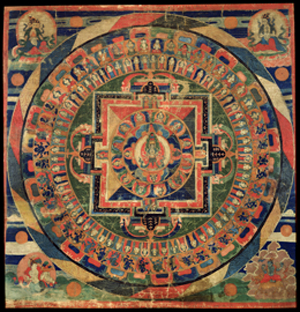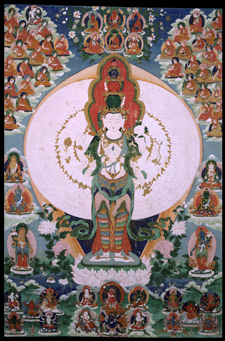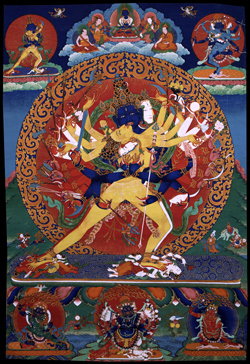The tradition of Himalayan tantric art evolved over more than a thousand years into a form notable for its iconographic complexity and stunning beauty. In December, Tricycle visited New York City’s Rubin Museum of Art, home of one of the West’s richest collections of Himalayan art. In this interview RMA curator Jeff Watt pulls back the curtain on this potent Buddhist art form.
What role can art play in conveying the Buddhist teachings? Buddhists are always talking about tools to use on the path to liberation. Often we are accused of living in our heads, of being too abstract. Buddhist art—and more specifically, tantric art—gives us the opportunity to come down to earth and look at how Buddhism represents itself visually. How is the Buddha represented? How are his teachings and followers represented?

Can you say something about tantra itself, and tantric art? Tantra is simply a method to reach enlightenment quickly, in one lifetime. It belongs to Northern Buddhism, the Mahayana school, although it once pervaded much of Buddhist Asia, including Southeast Asia and Sri Lanka. Tantric paintings are the visual representations of tantric texts, which outline expedient practices. The texts themselves are primarily understood as revelation, and are said to be the words of the Buddha in his divine or transcendent aspect. Most tantric texts were written down between the fourth and tenth centuries C.E., and tantric art developed alongside of the texts.
And how does tantric art represent the teachings in tantric texts? The deities in the paintings are personifications of the texts and the systems of practice they teach. Tantric art actually compresses all of the important points of the Buddhist teachings into a very tight visual package of symbols.
Are the deities thought to actually exist? Deities in the tantric system don’t exist as external entities. They’re expressions of Buddhahood, they are emanations of a particular Buddhist teaching. These deities are peaceful, fearsome, and wrathful; they’re multiheaded and multiarmed, each one suited to the temperament of an individual tantric practitioner. Although the images are visually arresting, they are merely mnemonic devices. For instance, often a deity will have, say, four faces, symbolizing the four Brahma-viharas, the Four Immeasurables—love, compassion, joy, and equanimity—fundamental principles in all Buddhist practice. The four-faced deity is only one very basic example of tantric iconography. The symbols are complex and many, and a single image can contain within it all of the essential Buddhist teachings, including the teachings of the Pali canon and the Mahayana sutras. And each image will often contain a central metaphor. In the case of the Kalachakra painting, for instance, the metaphor is time. The central metaphor, whether it’s death, beauty, fierceness, royalty, or the like, serves as the thematic matrix out of which the symbols emerge. It’s a means of bundling the iconography up into a single motif.
We often see male and female figures locked in embrace, as in the Kalachakra painting. What do they represent? When you have a male and a female locked in embrace, usually the male represents the phenomenal world of appearance, existence as we know it—what we hear, smell, taste, and so on. The female represents the Buddhist concept of emptiness, shunyata, the essentially void nature of phenomena. From a Buddhist point of view, nothing can come into existence unless you have emptiness, the purely contingent nature of phenomena. Emptiness is the template out which phenomena appear and into which they disappear. With the deities embracing we have a union of the two, a representation of nonduality. The male-female union is also a representation of the union of compassion (or method) and wisdom. This is a basic example of how a fundamental Buddhist principle is contained and expressed in tantric art. Understanding the relationship between appearance and emptiness is central to tantric Buddhism, and actually experiencing it, rather than simply knowing it intellectually, is key.
How does the art help us to actually experience this principle? In tantric practice, there are two types of meditation: the “generation stage” and the “perfection stage.” The generation stage is essentially a visualization practice, using the images depicted in the art as subjects. The deities are visualized in a formal meditation session done one, two, three, or six times a day, for anywhere from five minutes to an hour or more. The meditation can be thought of as a rehearsal of the stages of the path to enlightenment: all the key points are brought to mind, all the steps required are there—the mental states to be accomplished and the negative emotional states to be overcome. Also, throughout the course of one’s day, there are activities that may relate to a specific deity that need to be reflected on, whether one is at work or at leisure.
It’s worth mentioning that there are so many different subjects in Buddhist tantric art because different metaphors and themes suit different kinds of people. Some may have an affinity for a wrathful deity, some may be more receptive to a peaceful one; and another, more complex mind may be suited to, say, the multilayered symbology found in the form of the Kalachakra, with all of its cogs and wheels representing time.
So yes, this art is a key to the practice. With perfection-stage meditation, however, imagery is not used. This further stage of meditation, based on a certain level of accomplishment with the generation stage, concerns itself with direct experience with the ultimate view of Buddhist reality—Mahamudra, Dzogchen, the Great Middle Way—without reliance upon fabricated symbols.
Are the mandala paintings essentially mnemonic devices? Yes. The mandala represents the totality of the universe, and each deity resides within one. The relationship between the deity and the mandala is the relationship between the animate and the inanimate. The deity represents oneself and the surrounding mandala represents the world one lives in. Typically you have a figure in a square, representing a deity in his or her palace, with four doors. Tantra’s foundation comprises the fundamental Buddhist teachings, so different features of the palace represent what in Buddhism are known as the “thirty-seven factors of enlightenment”—the steps leading to enlightenment, including and beginning with the Four Noble Truths, which the four doors represent. It’s a little bit like Shakespeare’s Globe Theatre, in which actors used architectural features to remember their lines. Likewise, the tantric practitioner uses the different features of a mandala—a metaphorical palace—to remember the thirty-seven factors of enlightenment.
Most tantric art contains a complete system of teachings, and the mandala is no different. What’s more, surrounding the entire mandala is an outer ring. Much like our current Western view, the tantric Buddhist view, developed over fifteen hundred years ago, describes the universe as a sphere, and what this ring actually represents is the sphere of the universe. So tantric art is meant to represent not just Buddhist teachings and cosmology, but the world and universe as a whole.

Avalokiteshvara: not giving up
In the painting opposite, a theme taken from the Mahayana sutras is used to create a deity. In theMani Kabum, a seventh-century text, Avalokiteshvara, the
Bodhisattva of Compassion, vowed to establish all sentient beings in enlightenment. “If ever I should break this vow,” he said, “may my head split into pieces.” He tirelessly worked toward emptying the hells—the hungry ghost realm, the animal realm, the human realm, and so on—but every time he looked back, he saw that these realms were filled with ever more sentient beings. Finally he became exhausted and despaired of ever making progress. He decided it would be best if he worked only for the benefit of himself. At that moment, his head shattered into pieces.
Amitabha Buddha, lord of the Pure Land, saw this, gathered the pieces, and stacked them in sets of three, one atop the other. The bodhisattva Vajrapani, in a wrathful form, offered help and put his own head atop those nine. Amitabha Buddha, vowing to be always present, then placed his own head atop all ten. The bottom ten heads, including Vajrapani’s, are also a reference to the tenparamitas, the virtues one must develop in order to become enlightened: generosity, discipline, patience, courage, meditation, wisdom, skillful means, vow, power, and knowledge. Further aiding Avalokiteshvara in his quest to liberate all sentient beings, the thousand buddhas of the current cosmological cycle each offered up the symbol of an eye, which appear in the palms of the hands of Avalokiteshvara’s thousand arms.
In his upraised right hand Avalokiteshvara holds a crystal mala (prayer beads) representing the bringing of all beings to the state of enlightenment as the beads are drawn toward the heart. In the upraised left is a crystal lotus symbolizing that Avalokiteshvara is of this world but not stained by it. The other two hands are held in the prayer gesture at the heart, requesting all Buddhas to remain in the world and teach. The wishfulfilling jewel held between the two hands represents the Buddha-nature found within all beings and the wish for all beings to reach enlightenment.
–Jeff Watt
Kalachakra: the wheel of time
This exquisite Sakya thangka [opposite] depicts Kalachakra surrounded by several deities, including Kalachakra’s wrathful protector aspect, Vajravega, at the

bottom center. Kalachakra stands in sexual union with his consort Vishvamata upon a lotus and three flattened discs of the white moon, the red sun, and the blue “eclipse planet” Rahu. These discs represent the three main energy channels of the “subtle body”: the white left “lunar,” the red right “solar,” and the blue central channel. Kalachakra has four faces, three throats, six shoulders, twenty-four arms and two legs. His torso is deep blue in color, his right leg is red, and his left leg is white. These three colors symbolize the purities of the deity’s mind, speech and body as the essences of the three channels. With his feet he tramples upon the hearts of the red-and-white four-armed Hindu gods Kamadeva and Rundra, while their white consorts try to lift his heels. These gods represent Kalachakra’s suppression of the two extremes of samsara and nirvana, and his annihilation of the four “demonic obstructions” and “emotional defilements.”
Kalachakra’s main face is black and angry; his right face red and passionate; his left face white and peaceful, and his rear face yellow and meditative. Respectively these four faces represent his mind, speech, body, and wisdom aspects; and his “four activities” of wrath, subjugation, pacification, and enrichment. Each face has three eyes that gaze over the three realms and times, with all twelve eyes protecting the twelve sun signs. His three throats and six pairs of shoulders are colord black, red and, white, symbolizing the three “qualities” of inertia, activity, and equilibrium. His twenty-four arms extend into eight black lower, eight red middle, and eight white upper arms, with hand holding a symbolic implement or weapon. Collectively these arms sent the twenty-four fortnights of the lunar year.
Each finger of his hands is colored yellow, white, red, black, and green from the thumb outwards, with their knuckle joints colored black, red, and white from the palms outward. The 15 joints of his twenty-four hands make a total of 360, symbolizing the 360 days of the lunar year and the 360 bones of the human body. He wears a long silk “vajra-scarf,” a loosened tiger-skin loincloth, and as symbols of the “six perfections” the six jewel ornaments of a bodhisattva.
Vishvamata has four faces, eight arms, and two legs. She is naked and passionately presses her body against Kalachakra, with symbolizing the female solar aspect of her “vajra-awareness.” Her eight extended arms represent the three “qualities” and the five sense faculties, with each hand holding a specific attribute. She wears the five “male or method” perfections, while she herself embodies the sixth “female” perfection of wisdom.
–Abridged from a text by Robert Beer and Edward Henning.